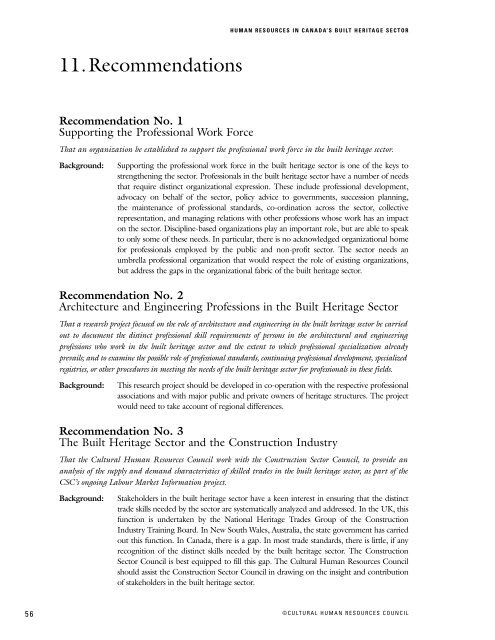Human Resources in Canada's Built Heritage Sector: Mapping the ...
Human Resources in Canada's Built Heritage Sector: Mapping the ...
Human Resources in Canada's Built Heritage Sector: Mapping the ...
- No tags were found...
Create successful ePaper yourself
Turn your PDF publications into a flip-book with our unique Google optimized e-Paper software.
HUMAN RESOURCES IN CANADA’S BUILT HERITAGE SECTOR11.RecommendationsRecommendation No. 1Support<strong>in</strong>g <strong>the</strong> Professional Work ForceThat an organization be established to support <strong>the</strong> professional work force <strong>in</strong> <strong>the</strong> built heritage sector.Background:Support<strong>in</strong>g <strong>the</strong> professional work force <strong>in</strong> <strong>the</strong> built heritage sector is one of <strong>the</strong> keys tostreng<strong>the</strong>n<strong>in</strong>g <strong>the</strong> sector. Professionals <strong>in</strong> <strong>the</strong> built heritage sector have a number of needsthat require dist<strong>in</strong>ct organizational expression. These <strong>in</strong>clude professional development,advocacy on behalf of <strong>the</strong> sector, policy advice to governments, succession plann<strong>in</strong>g,<strong>the</strong> ma<strong>in</strong>tenance of professional standards, co-ord<strong>in</strong>ation across <strong>the</strong> sector, collectiverepresentation, and manag<strong>in</strong>g relations with o<strong>the</strong>r professions whose work has an impacton <strong>the</strong> sector. Discipl<strong>in</strong>e-based organizations play an important role, but are able to speakto only some of <strong>the</strong>se needs. In particular, <strong>the</strong>re is no acknowledged organizational homefor professionals employed by <strong>the</strong> public and non-profit sector. The sector needs anumbrella professional organization that would respect <strong>the</strong> role of exist<strong>in</strong>g organizations,but address <strong>the</strong> gaps <strong>in</strong> <strong>the</strong> organizational fabric of <strong>the</strong> built heritage sector.Recommendation No. 2Architecture and Eng<strong>in</strong>eer<strong>in</strong>g Professions <strong>in</strong> <strong>the</strong> <strong>Built</strong> <strong>Heritage</strong> <strong>Sector</strong>That a research project focused on <strong>the</strong> role of architecture and eng<strong>in</strong>eer<strong>in</strong>g <strong>in</strong> <strong>the</strong> built heritage sector be carriedout to document <strong>the</strong> dist<strong>in</strong>ct professional skill requirements of persons <strong>in</strong> <strong>the</strong> architectural and eng<strong>in</strong>eer<strong>in</strong>gprofessions who work <strong>in</strong> <strong>the</strong> built heritage sector and <strong>the</strong> extent to which professional specialization alreadyprevails; and to exam<strong>in</strong>e <strong>the</strong> possible role of professional standards, cont<strong>in</strong>u<strong>in</strong>g professional development, specializedregistries, or o<strong>the</strong>r procedures <strong>in</strong> meet<strong>in</strong>g <strong>the</strong> needs of <strong>the</strong> built heritage sector for professionals <strong>in</strong> <strong>the</strong>se fields.Background:This research project should be developed <strong>in</strong> co-operation with <strong>the</strong> respective professionalassociations and with major public and private owners of heritage structures. The projectwould need to take account of regional differences.Recommendation No. 3The <strong>Built</strong> <strong>Heritage</strong> <strong>Sector</strong> and <strong>the</strong> Construction IndustryThat <strong>the</strong> Cultural <strong>Human</strong> <strong>Resources</strong> Council work with <strong>the</strong> Construction <strong>Sector</strong> Council, to provide ananalysis of <strong>the</strong> supply and demand characteristics of skilled trades <strong>in</strong> <strong>the</strong> built heritage sector, as part of <strong>the</strong>CSC’s ongo<strong>in</strong>g Labour Market Information project.Background:Stakeholders <strong>in</strong> <strong>the</strong> built heritage sector have a keen <strong>in</strong>terest <strong>in</strong> ensur<strong>in</strong>g that <strong>the</strong> dist<strong>in</strong>cttrade skills needed by <strong>the</strong> sector are systematically analyzed and addressed. In <strong>the</strong> UK, thisfunction is undertaken by <strong>the</strong> National <strong>Heritage</strong> Trades Group of <strong>the</strong> ConstructionIndustry Tra<strong>in</strong><strong>in</strong>g Board. In New South Wales, Australia, <strong>the</strong> state government has carriedout this function. In Canada, <strong>the</strong>re is a gap. In most trade standards, <strong>the</strong>re is little, if anyrecognition of <strong>the</strong> dist<strong>in</strong>ct skills needed by <strong>the</strong> built heritage sector. The Construction<strong>Sector</strong> Council is best equipped to fill this gap. The Cultural <strong>Human</strong> <strong>Resources</strong> Councilshould assist <strong>the</strong> Construction <strong>Sector</strong> Council <strong>in</strong> draw<strong>in</strong>g on <strong>the</strong> <strong>in</strong>sight and contributionof stakeholders <strong>in</strong> <strong>the</strong> built heritage sector.56©CULTURAL HUMAN RESOURCES COUNCIL










